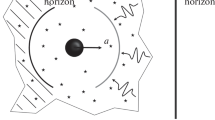Abstract
This paper reviews the origin of inertia according to Mach's principle and Weber's law of gravitation. The resulting theory is based on simultaneous nonlocal gravitational interactions between particles in the solar system and others in the remote universe beyond the Milky Way galaxy. It explains the precession of the perihelion of Mercury. A most important implication of the Mach-Weber theory of the force of inertia is the necessity for a large amount of uniformly distributed matter in the galactic universe. This matter could be the source of the cosmic background radiation. Nonlocal inertia forces are compatible with a static universe and also with an expanding universe but the latter would demand slow changes in the mass of particles and the gravitational constant.
Similar content being viewed by others
References
Y. Aharonov and D. Bohm, “Significance of electromagnetic potentials in quantum theory,”Phys. Rev. 115, 485 (1959).
G. Moellenstedt and W. Bayh, “Messung der kontinuierlichen Phasenschiebung im kraftfreiem Raum durch das magnetische Vektor Potential,”Naturwissenschaften 49, 81 (1962).
J. S. Bell,Speakable and Unspeakable in Quantum Mechanics (Cambridge University Press, New York, 1987).
A. Aspect, J. Dalibard, and G. Roger, “Experimental test of Bell's inequalities using time-varying analyzers,”Phys. Rev. Lett. 49, 1804 (1982).
J. P. Wesley,Phys. Essays 7, 240 (1994).
P. Graneau,Ampére-Neumann Electrodynamics of Metals, 2nd edn. (Hadronic Press, Palm Harbor, 1994).
P. Graneau, “Nonlocal action in the induction motor,”Found. Phys. Lett. 4, 499 (1991).
P. Graneau, “Electromagnetic jet-propulsion in the direction of current flow,”Nature 295, 311 (1982).
P. Graneau, “First indication or Ampère tension in solid electric conductors,”Phys. Lett. A 97, 253 (1993).
P. Graneau, “Wire explosions,’Phys. Lett A 120, 77 (1987).
P. T. Pappas, “The original Ampère force and Biot-Savart and Lorentz forces,”Nuovo Cimento B 76, 189 (1983).
P. G. Moyssides and P. T. Pappas, “Rigorous quantitative test of Biot-Savart-Lorentz forces,”J. Appl. Phys. 59, 19 (1986).
P. Graneau, “Railgun Recoil and relativity,”J. Phys. D 20, 391 (1987).
P. G. Moyssides, “Experimental verification of the Biot-Savart-Lorentz and Ampère force laws in a closed circuit, revisited,”IEEE Trans. Magn. 25, 4313 (1989).
A. K. T. Assis, “On the mechanism of railguns,”Galilean Electrodynam. 3, 93 (1992).
J. Nasilowski, “A note on longitudinal Ampère forces in gaseous conductors,”Phys. Lett. A 111, 315 (1985).
T. E. Phipps, Jr., “New evidence for Ampère longitudinal forces,”Phys. Essays 3, 198 (1990).
T. E. Phipps and T. E. Phipps, Jr., “Observation of Ampère forces in mercury,”Phys. Lett. A 146, 6 (1990).
A. K. T. Assis, “On Mach's principle,”Found. Phys. Lett. 2, 301 (1989).
W. Weber,Wilhelm Weber's Werke, 6 volumes (Springer, Berlin, 1892–4); see especially Vol. 4, p. 479.
M. F. Tisserand, “Sur le mouvement des planètes autour du soleil, d'après la loi électrodynamique de Weber,”C. R. Acad. Sci. (Paris) 75, 760 (1872).
P. Graneau, “Interconnecting action-at-a-distance,”Phys. Essays 3, 340 (1990).
E. Schrödinger, “Die Erfüllbarkeit der Relativitätsforderung in der klassischen Mechanik,”Ann. Phys. (Leipzig) 77, 325 (1925).
A. Einstein, “Prinzipielles zur allgemeinen Relativitätstheorie,”Ann. Phys. (Leipzig) 55, 241 (1918).
E. Mach,The Science of Mechanics (Open Court, La Salle, 1960).
L. I. Schiff, “Observational basis of Mach's principle,”Rev. Mod. Phys. 36, 510 (1964).
A. K. T. Assis, “Centrifugal electrical force,”Commun. Theor. Phys. 18, 475 (1992).
A. K. T. Assis, “Changing the inertial mass of a charged body,”J. Phys. Soc. Japan 62, 1418 (1993).
D. W. Sciama, “On the origin of inertia,”Mon. Not. R. Astron. Soc. 113, 34 (1953).
G. B. Brown,Retarded Action-at-a-distance (Cortney Publications, Luton, 1982).
H. J. Treder,Die Relativitaet der Tragheit (Akademie-Verlag, Berlin, 1972).
W. F. Edwards, “Inertia and an alternative approach to the theory of interactions,”Proc. Utah Acad. Sci., Arts, Lett. 51 (2), 1 (1974).
J. B. Barbour and B. Bertotti, “Gravity and intertia in a Machian framework,”Nuovo Cimento B 38, 1 (1977).
P. B. Eby, “Perihelion precession as a Machian effect,”Lett. Nuovo Cimento 18, 93 (1977).
A. Ghosh, “Velocity-dependent intertial induction: a possible tired-light mechanism,”Apeiron 9–10, 35 (1991).
A. P. French,Newtonian Mechanics (Norton, New York, 1971).
T. E. Phipps, “Should Mach's principle be taken seriously?”Spec. Sci. Technol. 1, 499 (1978).
P. Gerber, “Die räumliche und zietliche ausbreitung der gravitation,”Z. Math. II 43, 93 (1898).
H. Seeliger, “Bemerkung zu P. Gerbers Aufsatz: ‘Die Fortplanzungsgeschwindligkeit der Gravitation,”Ann. Phys. (Leipzig) 53, 31 (1917).
J. P. Wesley,Selected Topics in Advanced Fundamental Physics (Benjamin Wesly, Blumberg, 1991) pp. 185–189.
P. Graneau, “Some cosmological consequences of Mach's principle,”Hadronic J. Suppl. 5, 335 (1990).
E. Harrison, “Newton and the infinite universe,”Phys. Today 39, 24 (1986).
A. K. T. Assis, “On the absortion of gravity,”Apeiron 13, 3 (1992).
A. K. T. Assis, “A steady-state cosmology,” inProgress in New Cosmologies: Beyond the Big Bang, H. C. Arp, C. R. Keys, and K. Rudnicki, eds. (Plenum, New York, 1993), pp. 153–167.
H. Arp, G. R. Burbidge, F. Hoyle, J. Narlikar, and C. Wickramasinghe, “The extragalactic universe—an alternative view”nature 346, 807 (1990).
A. A. Penzias and R. W. Wilson, “A measurement of excess antenna temperature at 4080 mc/s,”Astrophys. J. 142, 419 (1965).
A. K. T. Assis,Weber's Electrodynamics (Kluwer Academic, Dordrecht, 1994).
Author information
Authors and Affiliations
Rights and permissions
About this article
Cite this article
Assis, A.K.T., Graneau, P. Nonlocal forces of inertia in cosmology. Found Phys 26, 271–283 (1996). https://doi.org/10.1007/BF02058089
Received:
Revised:
Issue Date:
DOI: https://doi.org/10.1007/BF02058089




